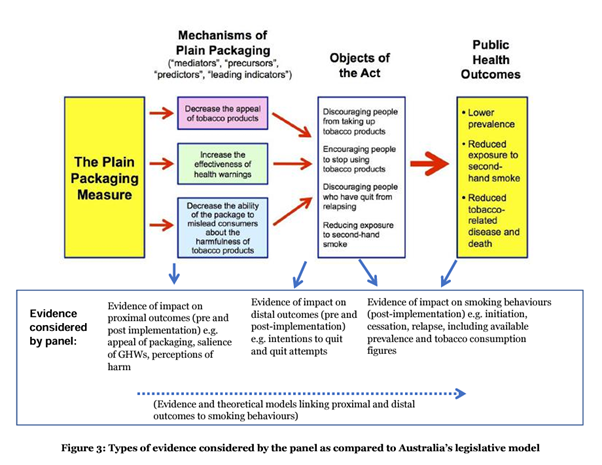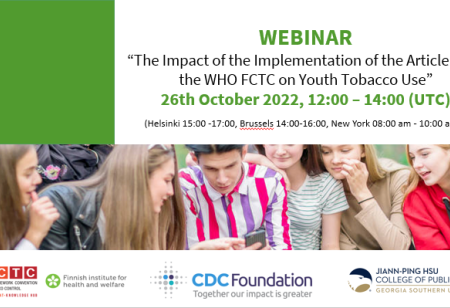
The role of evidence in defending tobacco control measures against legal challenges - 19 March 2024

The role of evidence in defending tobacco control measures against legal challenges
Tobacco control measures are often challenged in court by the tobacco industry or those representing its interests in order to stop, delay or weaken their implementation. For tobacco companies, a court case presents an opportunity to tie up resources, discourage others from considering similar measures, and cast doubt on the evidence behind the measure by putting forward misleading claims about the health or economic impacts of such measures.
Evidence is key to defending tobacco control laws. The trade, investment, and domestic legal frameworks under which legal challenges are typically launched include policy space for public health, so evidence is important to demonstrating how tobacco control measures contribute to public health. But what counts as evidence for the purpose of defending a legal challenge, and how do courts and tribunals assess public health evidence in their decisions? And why should scientists, policymakers and lawyers work together to develop strong tobacco control laws? In this blog, we outline some key lessons from legal challenges:
Focus on the big picture
The tobacco industry will often make extremely detailed arguments about flaws in individual studies, in order to argue that public health bodies have not demonstrated that a measure ‘works’. This was a tactic in legal challenges to many countries’ tobacco plain packaging laws. The intended effect of this is to obscure the strength of the overall evidence base – which in most cases will be what matters to a court or tribunal.
Countries should prepare the best available evidence in developing and defending a law, including by drawing on international evidence and recommendations. But they should also recognise when arguments about evidence are a litigation tactic to waste time and resources, and try to communicate the larger picture about the evidence base behind a measure.
Evidence includes a wide variety of methods and outcomes
Evidence to support the defence of legal challenges can include a wide variety of both pre- and post-implementation evidence. The tobacco industry will often try to limit evidence to post-implementation prevalence figures, because this figure may not have had sufficient time to change in the short time before a legal challenge is launched and it is difficult to show that changes in prevalence are caused by any given measure. But studies conducted before implementation, or on intermediate outcomes like consumer perceptions, are recognised by courts as an important source of evidence for novel and innovative tobacco control measures.
Courts and tribunals understand that the impact of any given measure may be difficult to isolate, particularly in the short term. In the World Trade Organization, for example, one of the key principles relating to the treatment of public health evidence is given by the WTO Appellate Body in the Brazil – Tyres dispute:
‘[C]ertain complex public health ... problems may be tackled only with a comprehensive policy comprising a multiplicity of interacting measures. In the short‐term, it may prove difficult to isolate the contribution to public health ... of one specific measure from those attributable to the other measures that are part of the same comprehensive policy. Moreover, the results obtained from certain actions — for instance ... certain preventive actions to reduce the incidence of diseases that may manifest themselves only after a certain period of time — can only be evaluated with the benefit of time.’: para 151.
In Australia – Plain Packaging WTO dispute, the WTO panel recognised the relevance of evidence not only on tobacco use prevalence and tobacco consumption, but evidence on impacts such as the appeal of tobacco packaging, whether consumers are misled by tobacco packaging, the effectiveness of graphic health warnings and quit attempts or calls to cessation services, as well as evidence about tobacco use prevalence and tobacco consumption. It rejected attempts by the complainant countries to limit the evidence base solely to prevalence data obtained in the three years after plain packaging’s adoption.

(Adapted by McCabe Centre from expert report by Fong et al, as cited in the Panel Report)
Evidence includes international instruments and recommendations
Many tobacco control measures included in the WHO FCTC and its guidelines, or recommended by international bodies such as WHO, have extensive international evidence bases, and countries can and should feel confident implementing them on the strength of that evidence. The WHO FCTC itself is also recognised as a source of evidence.
International evidence and experience is particularly important in countries or settings where resources for local studies may be limited. Countries do not need to reinvent the wheel when implementing measures. As the investment tribunal in Philip Morris v. Uruguay, a legal challenge to Uruguay’s tobacco packaging and labelling laws, noted:
‘For a country with limited technical and economic resources, such as Uruguay, adhesion to the FCTC and involvement in the process of scientific and technical cooperation and reporting and of exchange of information represented an important if not indispensable means for acquiring the scientific knowledge and market experience needed for the proper implementation of its obligations under the FCTC and for ensuring the fulfilment of its tobacco control policy … ‘In the Tribunal’s view, in these circumstances there was no requirement for Uruguay to perform additional studies or to gather further evidence in support of the Challenged Measures. Such support was amply offered by the evidence-based FCTC provisions and guidelines adopted thereunder.’ (paras 393-396)
The tobacco industry’s history of denying and manipulating evidence matters
Courts have recognised that the tobacco industry has a long history of manipulating evidence. Drawing attention to this history can help provide context for courts and tribunals. In the legal challenge to the United Kingdom’s tobacco plain packaging regulations, for example, the High Court of England and Wales noted that it was appropriate to ensure transparency and effective scrutiny of tobacco industry evidence given their history of manipulating scientific evidence:
‘[T]he sharp discord between what the tobacco companies think inside their own four walls and what they then say to the outside world (especially through experts), are so damning and the evidence of the discord so compelling and far reaching that it is not at all surprising that the WHO concluded that there was an evidence base upon which to found their recommendations to contracting states to apply vigilance and demand accountability and transparency in their dealing with the tobacco companies.’ – British American Tobacco v Secretary of State for Health (England and Wales High Court, 2016) para 21.
Scientists, policymakers and lawyers should work together
Collaboration between scientists, policymakers and lawyers can be powerful in advancing tobacco control laws, and it is important that this starts from very early in the process. This collaboration can help evidence-based laws get implemented, and “litigation-proof” laws by ensuring that the legislation and any documentation such as explanatory memoranda reflects the available evidence. It can also help raise awareness of article 5.3 of the WHO Framework Convention on Tobacco Control amongst national scientific communities, so that researchers understand the conflicts of interest and ethics risks inherent in accepting tobacco industry research funding or providing expert evidence for the tobacco industry in legal proceedings. Finally, it can ensure that in the event of a legal challenge, the overall evidence base supporting a measure can be well explained and give the law the best chance of being upheld. Supporting scientists, public health policymakers, and lawyers to work together will help more countries implement effective tobacco control laws and ultimately, save lives.
References
- Australia — Certain Measures Concerning Trademarks, Geographical Indications and Other Plain Packaging Requirements Applicable to Tobacco Products and Packaging, Appellate Body Report, WT/DS435/AB/R; WT/DS441/AB/R, 9 June 2020.
- Australia – Certain Measures Concerning Trademarks, Geographical Indications and Other Plain Packaging Requirements Applicable to Tobacco Products and Packaging, Panel Reports, WT/DS435/R, WT/DS441/R, WT/DS458/R, WT/DS467/R, 28 June 2018.
- Philip Morris v. Uruguay, ICSID Case No. ARB/10/7, Award, 8 July 2016
- British American Tobacco v. Secretary of State for Health (High Court and Court of Appeal of England and Wales, 2016)
The McCabe Centre hosts the Knowledge Hub on Legal Challenges to Implementation of the WHO FCTC. You can find more resources on dealing with legal challenges at https://extranet.who.int/fctcapps/fctcapps/fctc/kh/legalchallenges. This blog post was prepared by Suzanne Zhou, Manager – Prevention, and Whitny Kapa, Legal Policy Advisor, on behalf of the Knowledge Hub.





